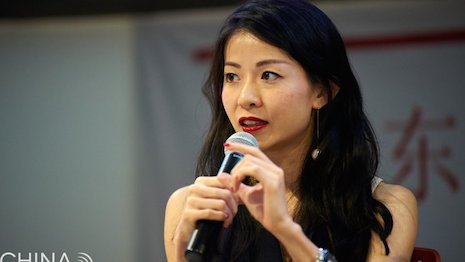 Aidaa Wong, cofounder/CEO of Luxsens, speaking at the recent China Connect Shanghai 2018 conference. Image credit: The Luxury Conversation
Aidaa Wong, cofounder/CEO of Luxsens, speaking at the recent China Connect Shanghai 2018 conference. Image credit: The Luxury Conversation
By Nick Withycombe Sometimes the hyperbole is justified. While headline statements can be guilty of lazily inserting top-shelf buzz such as game-changer, disruptor or next-gen for their tabloid effect, the talks at the China Connect conference warrant the provocative wordage. An event with talks that were both interesting and presented with aplomb, China Connect Shanghai 2018 brought together experts from a broad variety of fields. Here are some of the more eye-catching statements from the day. WeLife is in trial mode Sophia Ong, GM strategic partner and key account of Tencent, gave a captivating talk about WeChat – not just that brands must use it, but how best to make use of WeChat’s awe-inspiring functionality. WeLife is on the way to becoming retail reality. Recently trialed by Max Factor with an automated store, shoppers could scan the product themselves and pay on WeChat, or pay by facial scan. The feeling that this was found to give was, in fact, “leaving without paying” – with no set transaction moment, so that when the shopper left the store, she felt as if she was indeed leaving, rather than “paying and leaving.” For brands, the functionality is mind-blowing: Heatmaps show where shoppers walked, spent more or less time at, and further technology even showed how they interacted with products. Maybe they picked the product up, looked at it and did not buy it – giving vital information as to the reasons why they chose not to purchase or interact with it further. Artificial intelligence (AI) even read facial expressions to gauge the feelings of the shopper during each product interaction. Blockchain is set to impact the luxury and fashion industries around the world Alvin Foo, managing director of Reprise China, said: “Blockchain will drive the luxury industry towards a future in which attributes such as traceability and authenticity will be profoundly promoted. “By linking digital certificates to purchased goods, buyers of luxury can buy with greater level of confidence, regardless of whether they are purchasing from online or secondhand retailers,” he said. Aidaa Wong, cofounder/CEO of Luxsens, said: “Over $3 trillion worth of personal luxury goods sold in the last 20 years are sitting in people’s closets, and over $460 billion worth of counterfeits have been sold over the past years. “In the current secondary luxury goods market, buyers are unable to tell whether the goods they are purchasing are authentic or not,” she said. “Blockchain technology makes product information available on demand for both sellers and buyers via digital assets, each luxury product’s information and history are recorded and can be viewed by anyone in the network, sellers and buyers can view proof of how a product has been authenticated with details records.” Quotes sourced from Reprise China Chinese millennials are more knowledgable about luxury than their Western counterparts Yvonne Wang, president of Hearst Media China, spoke about luxury and millennials. She began by explaining that the balance has now shifted in terms of affluent Chinese being so into their luxury lifestyles that their understanding of brands, products, collections and even the industry, in general, has exceeded that of those elsewhere. It means that luxury brands need to realize that the affluent Chinese consumer, traveler, shopper, follower – whatever the definition – travels globally, shops extensively and has seen brands’ products, marketing and even pricing around the world. This means that a luxury brand needs to ensure that the most cutting-edge, next-level and culturally specific marketing, sales and operations is being done in China with the highest importance and care. Chinese millennials have turned “think feel do” into “feel do think” Joanna Lu, vice president of marketing for Greater China and Korea at Coca-Cola Co., gave an inspiring talk about stories, tales and thought processes, relevant to “the Age of More.” The Age of More means that people have more choices of more products, from more brands. How can you break-through the growth of more and engage with each person? One key point mentioned was not a new one, but an ancient human tradition – storytelling. From Coca-Cola’s aspect, it is blessed with one famous story: the secret recipe – a story that is known not just by customers, but by generations. What does a story do? Ms. Lu presented six key functions:
- Building belief
- Preserving knowledge
- Creating memory
- Unleashing imagination
- Delivering inspiration
- Creating possibility
- From storytelling to story doing:
- Mass becomes personalized
- Passive becomes participation
- Awareness becomes experiences
- Consumers become advocates
